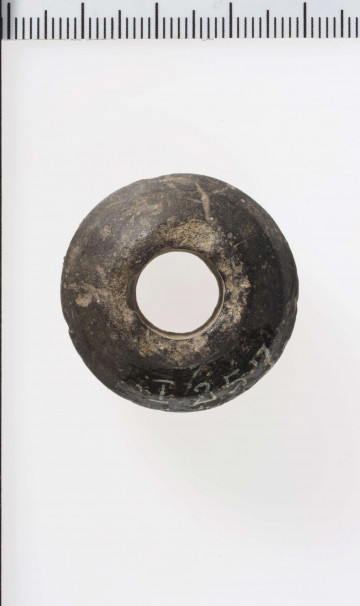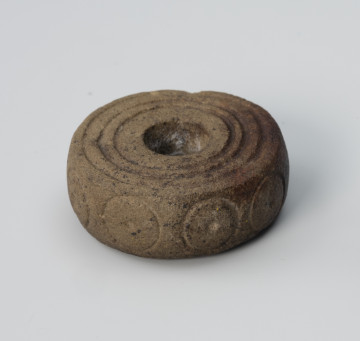
Spindle whorl
476 — 1453
National Museum in Lublin
Part of the collection: Set of archaeological relics found in the Lublin Region
A small weaving device, a spindle whorl made of clay, was discovered in a settlement of the Przeworsk culture in Nieszawa Kolonia, Opole poviat, Lubelskie voivodeship, located in the fork of the Vistula and Wyżnica Rivers. The settlement dates to the period between the 2nd and 4th centuries AD.
The site was discovered in 1979 during surface research conducted by archaeologists from the Maria Curie-Skłodowska University in Lublin. Systematic excavations were carried out by the staff of the Archaeology Department of the Lublin Museum in 1986: Anna Kloss (1986), Waleria Misiewicz and Marta Polańska (1996-1997) and Marta Stasiak-Cyran (1998-2008).
The spindle whorl with a two-conical cross-section form was hand-made of clay and fired in a light brown colour. The surfaces at the openings are flattened. On the outer sides of both cones there are engraved motifs in the form of a belt of vertical and diagonal lines grouped in sets of two to eight incisions. On the second strip of ornament the incisions are arranged in the form of a cross or a flower.
Spindle whorls are weaving tools designed to increase the inertia of the spindle and prevent the threads wound on it from slipping. They are quite common items found on archaeological sites from the Neolithic to the Middle Ages. However, they are usually not decorated. The spindle whorl from Nieszawa Kolonia is an interesting material source allowing to get closer to the spinning and weaving craft of the people of the Przeworsk culture.
Author / creator
Dimensions
cały obiekt:
Object type
weaving equipment
Technique
modelling
Material
clay
Creation / finding place
Owner
The National Museum in Lublin
Identification number
Location / status

476 — 1453
National Museum in Lublin

900 — 1100
National Museum in Szczecin
National Museum in Lublin
DISCOVER this TOPIC
Castle Museum in Łańcut
DISCOVER this PATH
Educational path